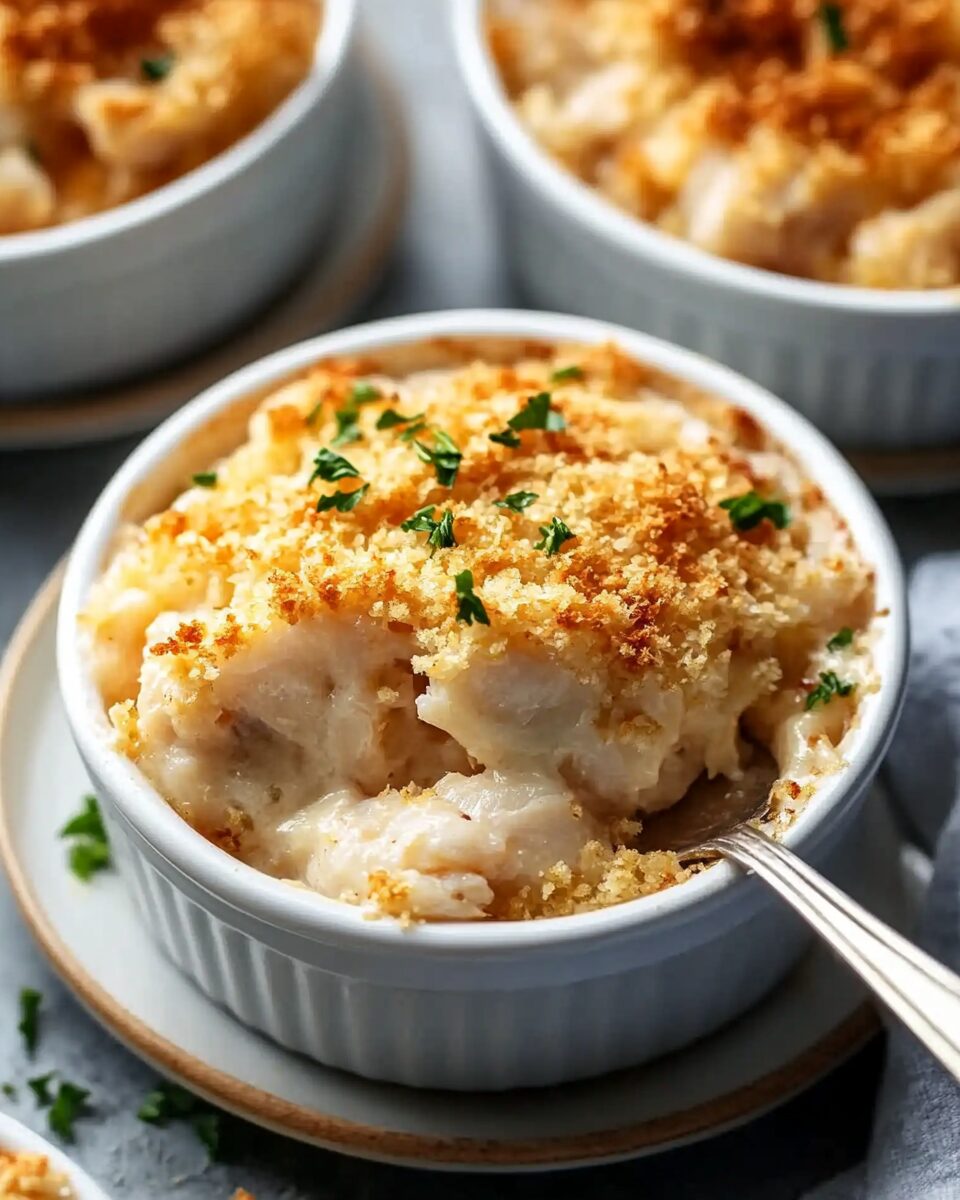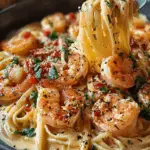Crab Imperial is a luxurious, Maryland-style seafood casserole featuring succulent jumbo lump crabmeat folded into a creamy, seasoned mixture and topped with crispy Panko breadcrumbs. Baked to golden perfection, this dish combines the rich flavors of mayo, Dijon mustard, Old Bay seasoning, and a touch of lemon for brightness. It’s simple to prepare yet elegant enough for special occasions or an upscale weeknight dinner. Whether served in individual ramekins or as a larger casserole, this dish brings coastal charm and indulgence to your table.
Full Recipe:
Ingredients
For the Crab Mixture
-
1 lb jumbo lump crabmeat, drained and picked over for shells
-
½ cup mayonnaise (Hellman’s or Duke’s recommended)
-
1 large egg, lightly beaten
-
1 tsp Worcestershire sauce
-
1 tsp Dijon mustard
-
1 tsp lemon juice, freshly squeezed
-
½ tsp Old Bay seasoning
-
¼ tsp salt
-
¼ tsp black pepper
-
2 tbsp unsalted butter, melted
-
1 tbsp fresh parsley, minced
For the Panko Topping
-
¼ cup panko breadcrumbs
-
1 tbsp unsalted butter, melted
-
1 tbsp Parmesan cheese (optional)
-
Paprika (for garnish)
Directions
-
Preheat the oven to 400°F (200°C) and lightly grease a 1-quart baking dish or four small ramekins.
-
In a large bowl, gently mix the crab, mayonnaise, egg, Worcestershire sauce, Dijon mustard, lemon juice, Old Bay seasoning, salt, and pepper. Be careful not to break the crab lumps.
-
Stir in melted butter and parsley until just combined.
-
Divide the mixture evenly among the ramekins or spread it in the baking dish.
-
In a small bowl, combine the panko breadcrumbs with melted butter and Parmesan cheese (if using). Mix well.
-
Sprinkle the topping over the crab mixture and dust with paprika.
-
Bake for 15–20 minutes until golden brown. For extra crispiness, broil for the final 1–2 minutes.
-
Serve hot with optional parsley garnish and lemon wedges.
Nutrients (Per Serving – Approximate)
-
Calories: 350
-
Protein: 26g
-
Fat: 26g
-
Saturated Fat: 8g
-
Carbohydrates: 6g
-
Fiber: 0g
-
Sugar: 1g
-
Sodium: 680mg
-
Cholesterol: 130mg
Rooted in Chesapeake Bay Tradition
The origins of Crab Imperial can be traced back to the culinary traditions of the Chesapeake Bay region, where blue crabs reign supreme and seafood is a way of life. This dish is a time-honored staple in many Mid-Atlantic homes and restaurants, often appearing on menus alongside classics like crab cakes and oysters Rockefeller.
While crab cakes aim for a firmer, pan-fried bite, Crab Imperial leans into creaminess and richness. It’s baked in a casserole-style dish or ramekins and served hot with a spoon, showcasing the delicate texture of crabmeat in a smooth, flavorful sauce.
This recipe captures the spirit of that tradition, combining regional flavors—like Old Bay seasoning and lemon—with the creamy base that makes this dish so comforting.
A Showcase for Jumbo Lump Crabmeat
What sets Crab Imperial apart from other seafood casseroles is the quality of crabmeat used. Jumbo lump crabmeat, prized for its large, whole pieces and sweet flavor, is the star of the show. Because the crab is already cooked and delicate, the recipe is designed to gently fold in the ingredients without overmixing or breaking apart the crab lumps.
This emphasis on preserving the integrity of the crab ensures that every bite offers a generous chunk of tender meat, with all the flavor that fresh seafood lovers crave. The other ingredients act as supporting characters—enhancing the flavor but never overshadowing the crab.
Simple Ingredients, Elegant Results
One of the beautiful things about Crab Imperial is how easy it is to prepare using pantry staples and a few fresh elements. The creamy mixture—typically made with mayonnaise, Dijon mustard, Worcestershire sauce, and lemon juice—creates a flavorful base that binds the crabmeat without masking its natural sweetness.
A dash of Old Bay seasoning ties everything back to the Mid-Atlantic roots of the recipe, delivering that familiar spicy warmth without overpowering the dish. A topping of buttery panko breadcrumbs adds contrast and crunch, giving it the perfect textural finish.
While it may look fancy when served in ramekins or plated with garnish, the actual process of making Crab Imperial is refreshingly straightforward, making it accessible even to beginner cooks.
Versatile Presentation for Any Occasion
Crab Imperial can be dressed up or down depending on the occasion. For a romantic dinner or formal gathering, serving it in individual ramekins adds elegance and helps portion the dish beautifully. Add a touch of fresh parsley or a lemon wedge for a bright, restaurant-quality finish.
Alternatively, it can be baked in a single casserole dish and served family-style with warm, crusty bread or buttery crackers. It pairs exceptionally well with simple vegetable sides like asparagus, sautéed spinach, or green beans. As a main course, it complements rice pilaf, mashed potatoes, or a light salad for a complete meal.
This versatility makes it a great option for holidays, dinner parties, or even upscale weeknight dinners when you want something a bit more special without too much effort.
A Perfect Balance of Richness and Brightness
While Crab Imperial is undeniably rich, the brightness of the lemon juice and the subtle tang of Dijon mustard provide balance. These acid-forward ingredients cut through the creaminess and lift the flavor, keeping the dish from feeling too heavy.
The addition of fresh parsley or a sprinkle of paprika on top not only adds visual appeal but also freshens the overall profile. The goal is a dish that tastes indulgent but remains light on the palate—something you’ll want to go back to for seconds.
Customizable to Your Taste
Although the traditional recipe has stood the test of time, Crab Imperial is highly customizable based on dietary needs or flavor preferences. You can adjust the level of seasoning to make it spicier, swap the panko topping for crushed Ritz crackers or gluten-free breadcrumbs, or even add a small amount of cream cheese for an extra velvety texture.
For a more modern spin, some chefs add a bit of sherry or white wine to the base mixture, lending additional depth and complexity. Others top the dish with a blend of cheeses for an au gratin-style finish. However, most purists agree that the real key is letting the crabmeat shine—so any additions should be subtle and complementary.
Easy to Prep, Easy to Impress
Another key appeal of Crab Imperial is how well it fits into a host’s cooking plan. It can be assembled a few hours in advance and baked just before serving, which means less stress and more flexibility if you’re entertaining. It also reheats beautifully, making it a great make-ahead option for dinner parties or holiday spreads.
Because it’s baked, there’s no risk of overcooking as long as you watch the top during the final minutes. The broiler step adds that final golden crust, giving the dish a professional look and satisfying crunch that seals in the creamy texture beneath.
A Low-Carb, High-Protein Favorite
Nutritionally, Crab Imperial is a smart choice for those following low-carb or keto diets. With very few carbohydrates and a high protein content, it satisfies without relying on starches or grains. The richness of the mayonnaise and butter offers satiety, while the crab delivers essential nutrients like vitamin B12, zinc, and omega-3 fatty acids.
It’s a dish that feels indulgent but aligns with many modern dietary goals, making it a popular choice for those who want a seafood-based main course that’s both decadent and nutritious.
Conclusion: A Timeless Classic That Deserves the Spotlight
Crab Imperial is one of those dishes that often flies under the radar—but once you try it, it quickly becomes a staple in your recipe collection. Its creamy, seasoned filling, luxurious crabmeat, and golden topping make it an irresistible blend of comfort and elegance. It’s the perfect way to showcase quality seafood without overwhelming it, and it delivers maximum flavor with minimal effort.
Whether you’re introducing guests to a taste of coastal Maryland or treating yourself to a refined seafood dinner, Crab Imperial always makes a statement. Its balance of richness and brightness, ease of preparation, and crowd-pleasing appeal make it a dish worth returning to again and again.
Serve it hot, enjoy it with your favorite sides, and savor every buttery, crab-filled bite—because some classics never go out of style.






